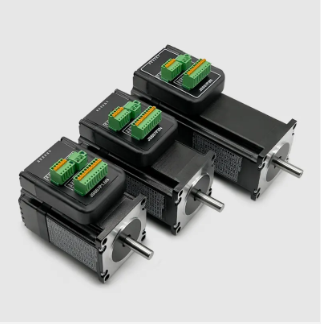Industrial Automation and Manufacturing Applications
Assembly Line Robots for High-Repetition Tasks
Servo drives really make a difference when it comes to making assembly line robots work better, especially those doing repetitive jobs all day long. What makes them so good? They offer pinpoint accuracy and consistent performance over and over again, something factories need if they want to keep their products top quality without tons of mistakes creeping in. Industry numbers back this up too – some studies show that automated systems can actually increase productivity somewhere around 30%. That's pretty impressive when we talk about adding servo tech to production lines. Take cars as an example. Auto manufacturers depend on these systems for everything from spot welding body panels to drilling holes and tightening bolts. Electronics makers get similar advantages too, thanks to the razor sharp movements and blistering speeds their robots achieve. At the end of the day, companies stay ahead of competitors because these systems ensure every product looks exactly like the last one while cranking out way more units than before.
Precision Machining in CNC Systems
Computer Numerical Control systems depend heavily on servo tech to boost performance and get those really precise machine jobs done. These servo drives basically make all the difference when it comes to hitting tolerances down to just 0.001 inches something absolutely necessary for any sector where accuracy matters most. Shops work with all sorts of stuff metals obviously, but also plastics and various composite materials through their CNC setups. When manufacturers integrate servos into their machines, they end up with consistently good cuts and shapes across the board. This matters a lot in places like aerospace engineering where even tiny deviations can cause big problems, plus in specialized manufacturing shops that need repeatable results every single time. Servo tech gives these machines both speed and pinpoint control, so it's pretty much become standard equipment in today's factories looking to stay competitive while meeting exacting quality standards.
Robotics and Advanced Motion Control Systems
Collaborative Robots in Smart Factories
Smart factories are seeing big changes thanks to collaborative robots, or cobots for short. These machines work right next to people on factory floors, combining the best of both worlds - robotic accuracy with human flexibility when needed. Some studies show that bringing cobots into production lines can actually increase output anywhere between 20% to almost 40%. What really stands out about these robots is how they can move around freely among workers without needing fences or protective enclosures, which is super important in fast paced settings. The secret behind their smooth operation lies in special components called servo drives that give them pinpoint control over movements. This lets the cobots switch between different jobs quickly and adjust to whatever comes their way. We see this happening all the time in places making cars and electronic devices, where getting things exactly right while keeping everyone safe matters most.
Surgical Robotics in Medical Equipment
Medical fields are seeing big changes thanks to surgical robots that take precision and minimally invasive techniques to new levels. These sophisticated machines rely on telemetry and live data feeds to handle complicated tasks requiring pinpoint accuracy and rock solid stability during operations. Research shows patients benefit greatly from robotic surgery approaches, often recovering faster and experiencing less pain after procedures. At the heart of these systems lie servo drives, those tiny but powerful components responsible for the super fine movements needed in delicate operations. Think about brain surgeries where doctors need to maneuver within fractions of a millimeter around critical areas. The way these drives integrate into robotic arms makes surgeries more dependable over time. As tech continues evolving, we're likely to see even better results from robotic procedures in the coming years.
Aerospace, Defense, and Satellite Applications
Aircraft Control Surface Positioning
Servo drives are essential for managing aircraft control surfaces and keeping planes flying properly. These systems adjust things like flaps and rudders with pinpoint accuracy, which makes a big difference in how well planes perform and stay safe during flight. The results speak for themselves according to data from major manufacturers such as Boeing and Airbus. Their reports show significant gains in both performance metrics and safety records since they started using advanced servo technology. Airlines that incorporate these drive systems report better handling characteristics and reduced maintenance issues over time. Fewer problems with control surfaces means pilots can focus on flying rather than constantly correcting course deviations, ultimately making air travel safer and more cost effective across the board.
Satellite Communication Alignment
Satellite antenna alignment just wouldn't work without servo drives these days. They're basically what keeps those dishes pointed exactly where they need to be for good signal reception. When engineers talk about signal strength, they often mention that proper alignment using servo technology can actually improve performance by around 50% in certain situations. That kind of difference matters when trying to send clear video feeds or critical data across vast distances. The industry is constantly pushing forward with new servo drive innovations too. Manufacturers are working on better positioning systems as more companies rely on satellites for everything from weather monitoring to global internet access. These improvements aren't just theoretical either; many space agencies have already started integrating upgraded drives into their latest communication arrays.
Emerging Innovations and Energy-Efficient Solutions
AI-Driven Servo Tuning for Ultra-Precise Control
Servo drive tuning is getting a major boost from artificial intelligence these days, making things run smoother and more accurately in all sorts of applications. When manufacturers start using AI tools, they find their setup times shrink quite a bit and adjustments happen much faster when conditions change, which means better productivity overall. Take automotive manufacturing for example AI algorithms constantly tweak those servo control settings on the fly, so machines respond quicker without wearing out as fast. Some recent tests indicate that these smart servo systems actually cut down energy usage around 20% give or take, something that definitely helps with running costs and environmental impact. What we're seeing here isn't just incremental improvement but a complete shift in what's possible with modern servo drive tech.
Renewable Energy System Integration
Servo drives have become really important in connecting renewable energy sources like wind farms and solar arrays to the grid, helping push environmental progress and greener practices. When engineers tweak how servo controls work, they get better performance from these systems, which means cleaner power gets converted and sent out more efficiently. Take wind turbines for instance. Servo drives let them change the angle of their blades depending on what the wind is doing at any given moment, so they can grab as much energy as possible no matter if it's blowing hard or just gently. Studies indicate that using this tech cuts down on carbon emissions quite a bit while also making it easier to scale up operations as our need for electricity keeps growing. We've seen this happen already with massive solar installations where servos adjust panels throughout the day to catch maximum sunlight, proving once again why precise control matters so much in today's renewable energy landscape.
FAQ
What are servo drives used for in manufacturing?
In manufacturing, servo drives are essential for enhancing the efficiency and precision of assembly line robots, CNC systems, and cobots, ensuring precise control and minimizing errors.
How do servo drives impact aerospace applications?
Servo drives improve aerospace applications by ensuring precise control of aircraft surfaces and satellite antenna alignment, thereby enhancing stability, safety, and communication quality.
Can AI improve servo system efficiency?
Yes, AI can significantly improve servo system efficiency by optimizing control parameters in real-time, resulting in reduced setup times and energy consumption.
How do servo drives contribute to renewable energy?
Servo drives optimize energy capture and conversion in renewable systems like wind turbines and solar panels, enhancing efficiency and supporting sustainability goals.

